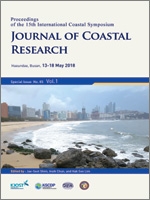Kim, J.B.; Kim, H.C.; Hong, S., and Park, J.-I., 2018. Mixed Aquaculture of Anadara broughtonii and A. kagoshimensis (Bivalvia: Arcidae) in Jinju Bay on the South Coast of the Korean Peninsula. In: Shim, J.-S.; Chun, I., and Lim, H.S. (eds.), Proceedings from the International Coastal Symposium (ICS) 2018 (Busan, Republic of Korea). Journal of Coastal Research, Special Issue No. 85, pp. 341–345. Coconut Creek (Florida), ISSN 0749-0208.
The biological characteristics and potential food resources of Anadara broughtonii and Anadara kagoshimensis were investigated from May 2013 to December 2014 to evaluate the effects of culturing the two species together (mixed aquaculture). There was no difference in sea water temperature between the surface and bottom layers, and salinity decreased after high rainfall. The three sites used as test shellfish farms had high mud contents and similar concentrations of chemical parameters in the sediment. To identify the potential food sources of the two species, carbon and nitrogen isotopes were analyzed using a mixing model. The results revealed that coarse particulate organic matter (CPOM) was the primary food for both species, comprising 88–89% of the total food source for A. broughtonii and 80–82% for A. kagoshimensis. There was no significant relationship between shell length, shell height, total weight, fresh tissue weight, dry tissue weight, or shell weight and A. broughtonii aquaculture type (mono or mixed), nor was there any significant relationship between shell length, shell height, or shell weight and A. kagoshimensis aquaculture type (mono or mixed). However, total weight, fresh tissue weight, and dry tissue weight were significantly higher in mixed aquaculture compared with those in A. kagoshimensis mono-aquaculture. Although A. broughtonii and A. kagoshimensis spats of similar weights were planted, the dry tissue weight of A. broughtonii was twice that of A. kagoshimensis after 5 months, and the difference increased to 3.8-fold upon harvest.





